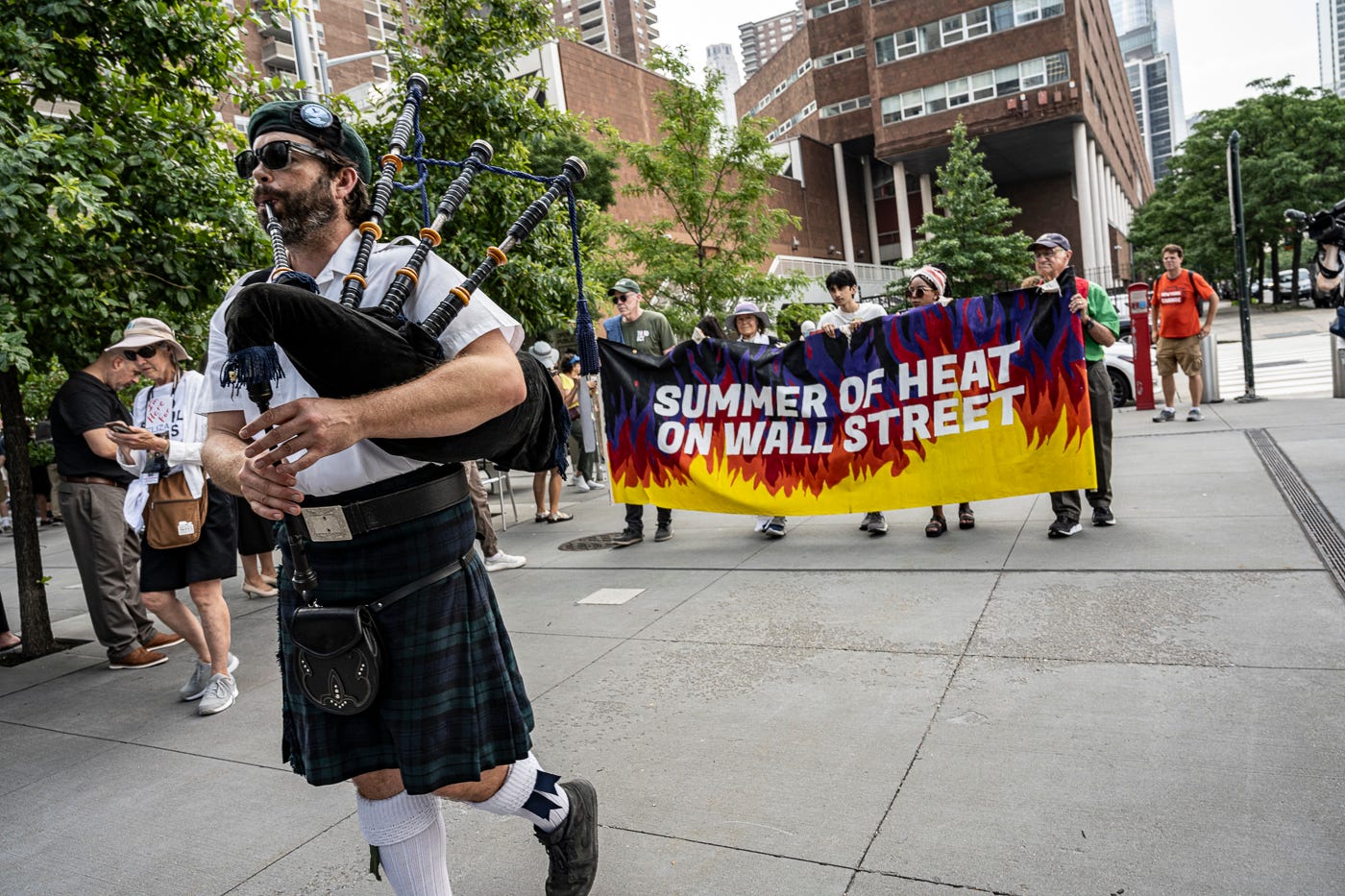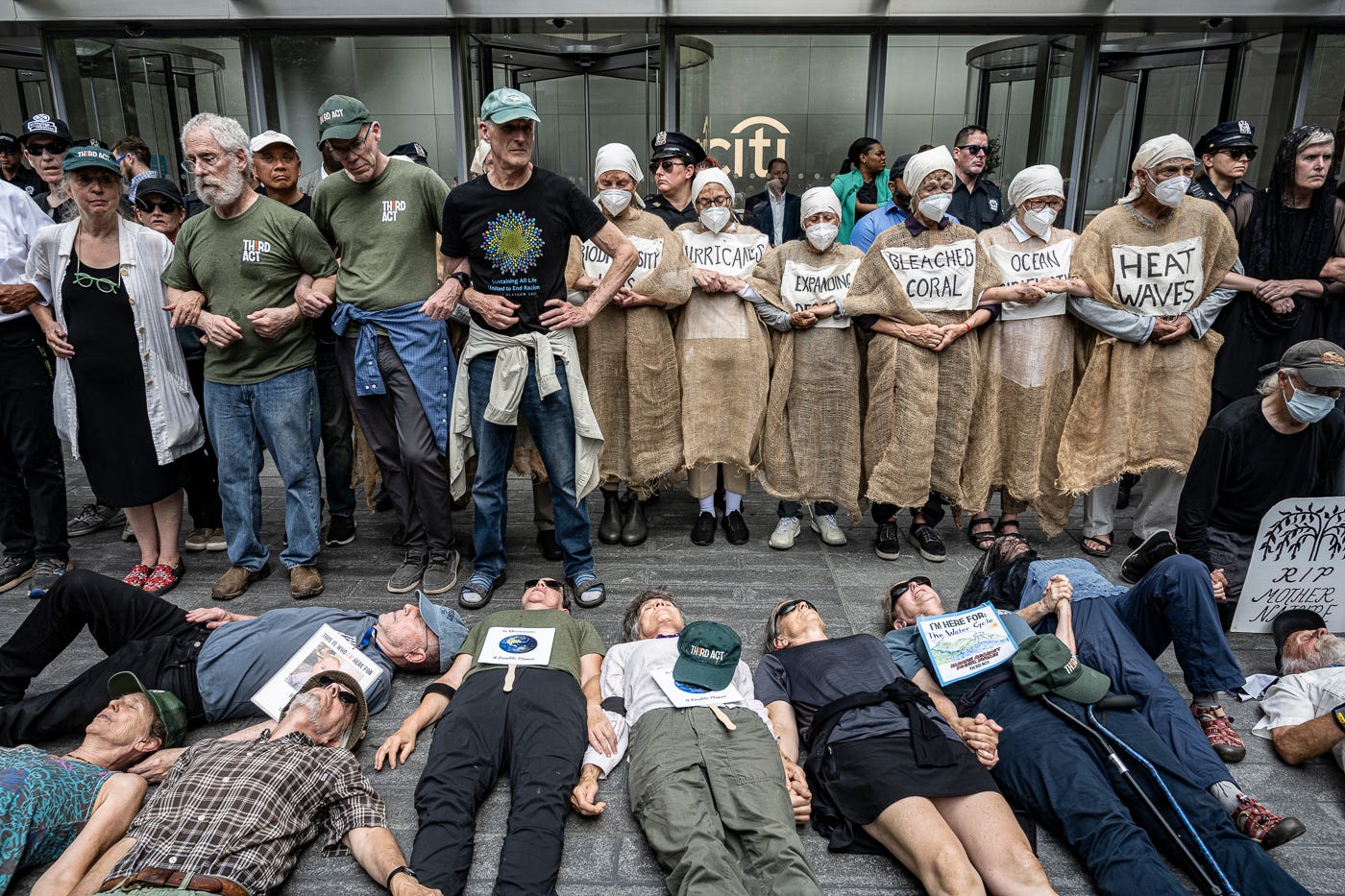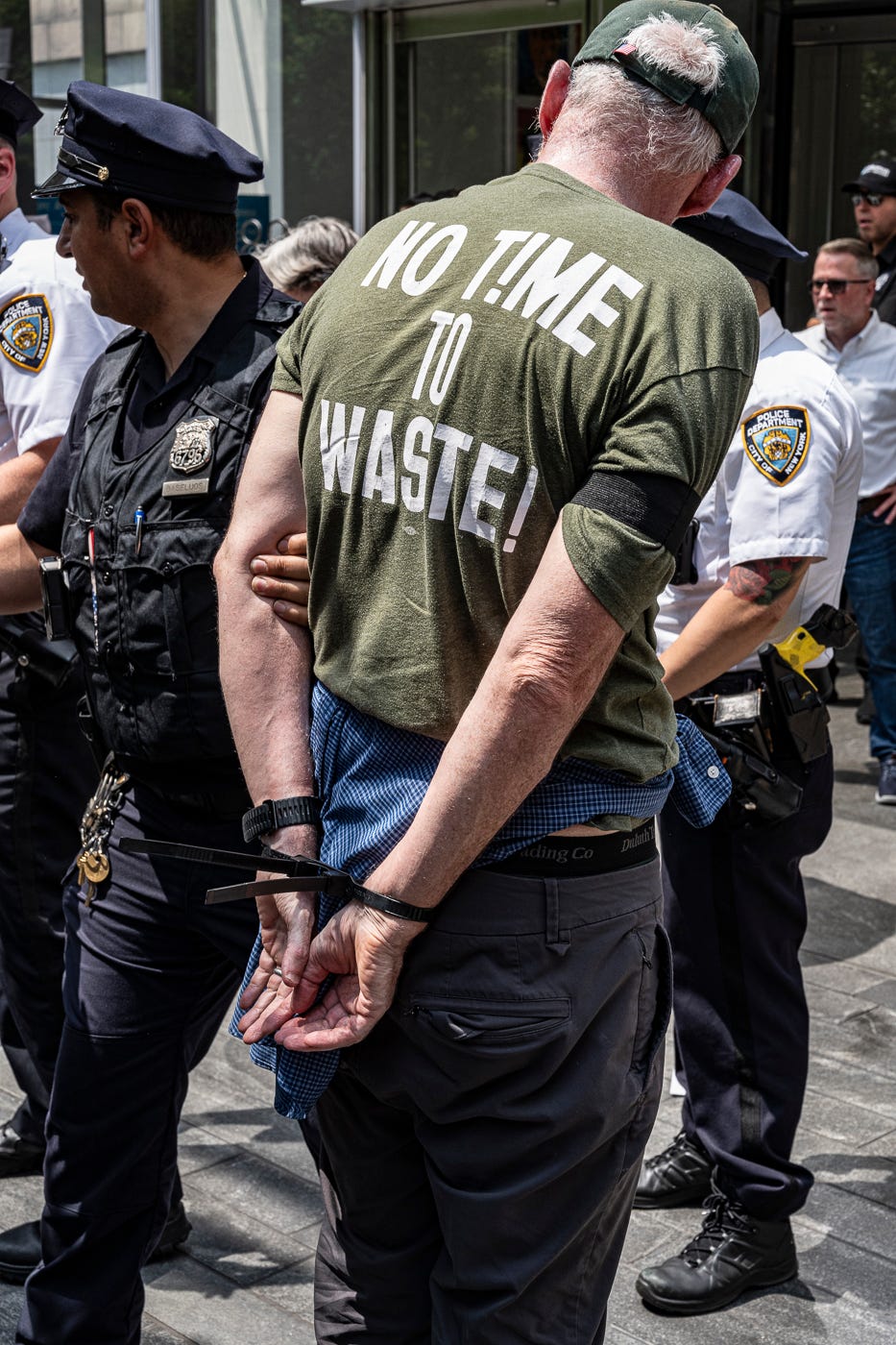I have, as you might imagine, been to a great many protests and demonstrations in my life. I think they’re one absolutely necessary component of movement building, which doesn’t stop me from thinking they can also too often be tedious—especially when it’s really hot outside, as it was in New York today. (Hot enough that the Third Ave Bridge over the Harlem River couldn’t open because the heat had swelled the steel). The day’s plan was to conduct a mock funeral outside the Financial District headquarters of Citibank, which I confess led me to think it might be a little cringe-worthy.
And I—as is fairly regularly the case—was wrong. It was one of the most remarkable protests I’ve ever been to, and I left (handcuffed in a paddy wagon) with a deep sense of appropriateness. Many hours later, finally out of the holding cell where I spent much of the day, that feeling lingers. One of our tasks for the moment is to learn how to effectively mourn, and this was a lesson in just that.
It began with eulogies—a few of us stood on a stepladder and spoke through a small sound system to the gathered throng of several hundred, almost all of them older Americans organized by Third Act. (It’s ‘elders week’ in this ongoing Summer of Heat protest outside Citibank). There were, as you would expect, some members of the clergy: Rev Lennox Yearwood (Church of God in Christ), Rev. Margarett Bullitt-Jonas (Episcopal), Rev. Jim Antal (United Church of Christ). A couple of younger people who’ve been organizing this summer’s protests also spoke—Liv Senghor, Keanu Arpels-Josiah—also spoke, as did Gus Speth, a veteran of the early days of the environmental movement and one of its most thoughtful and deep leaders.
And then a bagpiper appeared, and we began to follow in a long line as he very slowly processed around this giant glasswalled building. Bagpipes are loud, of course, but also solemn—often they’re used to honor noted dead, at the funerals of police or politicians. Here we were trying to bear in mind those anonymous millions who have already died from heatwave, flood, fire, and climate borne-disease, and the slow, steady skirl of the pipes led my mind drift to Bangladesh, where I watched the first big outbreak of dengue fever, and to Napa, where I saw the smoking ruins of fires that moved too fast, and to my own Vermont and the deadly floods of the summer past. When, turning the last corner on to Greenwich Street, he began to play Amazing Grace, I teared right up.
Eventually we arrived at the plaza outside the main doors of Citibank—which, remember, is the second-biggest all-time lender to the fossil fuel industry, handing over hundreds of billions of dollars even after scientists established the danger of coal and gas and oil, and after diplomats tried to rein them in. An octet of older people in sackcloth and ashes, with sashes that named the greatest dangers we face (“Ocean Acidification,” “MegaFires”) pressed up against the line of police, and some of us stood with them to symbolically block the doors, while others began to lie down in front—dying, as it were. As the names and stories of victims of heat around the world were read, a woman offered a lovely eerie soprano keening wail.
Eventually the police made it known that they would only arrest those laying on the ground, and so many of us reclined on the pavement. It had stayed cloudy till then, so the stones weren’t uncomfortably hot, but as we lay there the sun came blazing forth, and suddenly it was truly hot. Not 122 degrees in Delhi hot, not 121 degrees in Saudi Arabia hot, not 120 degrees in Las Vegas hot (these are all real readings from the last few weeks, and all all-time records). But still pretty searing, especially through the humid haze. Hot enough to be reminded, for a minute, of how we’ve taken the sun and turned it into our enemy, and how, of course, we could quickly redeem it as our friend—it has power, to hurt or to heal.
Eventually the police did their thing, and we were led away. (That’s me, in a Third Act t-shirt). Around me I could see others—Sandra Steingraber, the great biologist and author; Sheldon Pollock, Columbia Sanskrit professor and passionate activist who had done much to organize this day, many more old and new friends. We were led slowly to the police transport, blessedly air-conditioned, and then downtown to One Police Plaza.
The return from the solemn funeral to the mundane world of police bureaucracy was not so bad; it actually felt better than just walking away from church and resuming looking at your phone. (Having the police confiscate your screen may be one of the last ways left to guarantee some psychic refuge from the news of the day). We spent a few hours in a big holding cell, trading stories and jokes, which is part of learning to mourn effectively as well; one can’t be sad and solemn all the time, because all the time now is a little desperate, but we still have lives to live.
And so we shall.
In other energy and climate news:
+Mumbai flooded
Houston flooded
Nepal flooded
Wisconsin flooded
The West seared
The East seared
Southern Europe seared
+Will we soon have solar windows?
Transparent solar cells fit into the category of building-integrated solar power. One key benefit of building-integrated solar is the ability to squeeze more renewable energy from structures, rather than disturbing land for new solar arrays. Building-integrated systems can also reduce the cost of solar power, by leveraging exterior walls, roofing materials, and other elements of a structure.
For example, rooftop solar panels require the installation of racking systems to hold them in place, which adds labor and material costs. In contrast, a window with built-in solar cells can be ordered up from the factory, just like any other building element.
Additionally, thin film can be applied to a wide range of surfaces that are unavailable to silicon-based solar panels. It can be painted, sprayed, or applied by well known printing processes.
What about solar covered canals?
The first canal-based solar project in the U.S. is nearing completion on tribal lands south of Phoenix, Arizona.
Native Americans have been using canals to irrigate the Gila River Valley for thousands of years, starting with the Huhugam people. Now at least a small slice of the modern-day system of canals that winds through the area will double as a location for generating solar energy for the Pima and Maricopa tribes.
Thousands of miles of federally owned canals stretch across the country, channeling water to thirsty crops, rural communities, and hydropower plants. Placing solar panels over these canals could create a gigawatt-scale source of clean energy with lower environmental impact than large-scale solar farms, but so far the idea has been slow to catch on.
A canal solar concept was deployed in India about a decade ago, and it inspired Ben Lepley, the founder of engineering firm Tectonicus, to create designs, prototypes, and techno-economic analysis for such a project in the U.S. Those plans have resulted in the soon-to-be-commissioned Casa Blanca installation — a 1.3 megawatt, half-mile-long pilot project located on the Casa Blanca Canal, part of an extensive canal network owned by the Gila River Indian Community.
The pilot received money from a $25 million provision of the Inflation Reduction Act that supplies funding for the U.S. Bureau of Reclamation to design, study, and deploy projects that put solar panels over waterways. Lepley’s firm has also won a Department of Energy Small Business Innovation Research Grant and is working with the California Energy Commission and University of California, Merced on the project.
It’s early days for this technology, but another canal installation, Project Nexus, in California’s Turlock Irrigation District, broke ground in May of this year and has already constructed foundations. Developers expect it to be completed in 2025.
+The wondrous writer Barbara Kingsolver wrote the oath for members of the new federal Climate Corps—a pledge recited by the first 9,000 young people to sign up for jobs helping with the energy transition
I pledge to bring my skills, respect, and compassion to work every day, supporting environmental justice in all our communities.
I will honor nature’s beauty and abundance, on which we all depend, and commit to its protection from the climate crisis.
I will build a more resilient future, where every person can thrive.
I will take my place in history, working with shared purpose in the American Climate Corps on behalf of our nation and planet, its people, and all its species, for the better future we hold within our sight.
That’s enough for tonight.








Congratulations, Bill, both for your successful "funeral" I wish it were a real funeral for Citibank. Thanks for telling us about solar windows and solar panels over canals. It is no surprise the indigenous tribes have started this project. The Native Americans, regardless of tribe, have long regarded it their duty to protect and defend their environment, despite us white people's insistence that the accumulation of wealth was of greater importance
Beautiful.
I am a climate refugee. I have come to Michigan's upper peninsula to live near nature's lovely air conditioner, Lake Superior, for the balance of my days on the mother earth. If only humans won't find a way to ruin that, too.